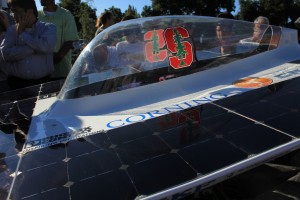It’s like Real World Silicon Valley meets the Mighty Ducks: 15 or so Stanford computer science, economics and engineering undergrads living together in one big house. They work summer jobs during the day and gather at night to labor over a project that they hope will bring them glory.
The students are members of the Stanford Solar Car Project. Their summer mission has been to create the world’s fastest student-built, solar-powered car, a product that has been two years in the making.

The team unveiled the spaceship like creation, called Xenith, to a large crowd at Stanford on Thursday. But while the car drew plenty of ooh’s and aah’s, it has yet to prove its racing prowess. To do that, it must beat out 41 other solar vehicles in a nearly 2,000 mile race across the Australian Outback this October.
The World Solar Challenge takes place every two years, challenging racers to create the most energy-efficient vehicles possible. Teams come from around the world to race. Stanford team members from previous races have gone on to work in the electric vehicle industry, at places like Tesla.
And while the Stanford team has stated its intentions to win this year, it is a bit of a dark horse. No American team has won the World Solar Challenge since 1987, when a General Motors vehicle took first place. Stanford ended the 2007 race dramatically when it blew a tire, flipped and wrecked. In 2009, Stanford’s team improved its performance by being one of only 10 to actually finish the race – but it did so in last place, slowed by an electrical failure.
Wesley Ford, the Stanford team’s financial manager, considers the University of Michigan’s Solar Car Team to be Stanford’s greatest racing rival, well funded by the automotive industry and boasting about one hundred members to Stanford’s roughly 30. Michigan finished third in the 2009 race and boldly describes itself as “America’s #1 Solar Car Team.”
“We have the best shot we’ve ever had, given what the competition is looking like,” said a confident-sounding Chris Hilger, business director for the Michigan team.

When asked what teams posed the toughest competition, he mentioned Japan and Europe, but not Stanford. When asked specifically about Stanford, he said that he hadn’t looked closely at the car, but that it seemed “strong”. But, he added, “We feel we have a really strong car.”
Ford acknowledged that the team did fall off the map when it finished poorly in 2009, but said that the low profile could provide the team with an advantage.
But he also questioned Michigan’s seeming disinterest. He said the Stanford team tracks where its website traffic comes from, and the top two states are California and Michigan.
“If it’s not Michigan’s solar team visiting our site,” he said, ” then we don’t know who in Michigan is so fascinated.”
He also spoke with confidence about Stanford’s chances this year. So far, about $500,000 worth of donated parts and time have gone into Xenith, in addition to about 10,000 hours worth of team labor. Businesses like Volkswagen and Corning have donated to the project. And in 2005, he points out, the team did win in the North American Solar Challenge.
Two weekends ago, the team finished working on the car at three in the morning, then headed to the central valley to test drive it.

Cruising at around 55 miles per hour as dawn broke, the car logged about 200 miles on the long, flat roads.
“Even though Michigan is bigger,” Ford said, “We think we’re kind of clever, and we have some tricks up our sleeve.” Tricks including solar panels the team claims to be the most efficient in the world, a wafer-thin, aerodynamic profile, and a motor the team says is the most efficient in solar car history.
There are other advantages, Ford said, but those are secrets the team plans on keeping until after the race.
[youtube]E6u6SJarZy4[/youtube]
